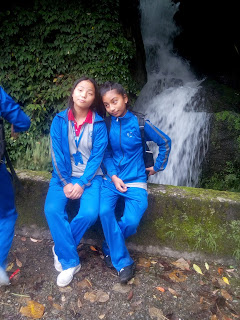Monsoon hiking at bishnudwar
Title : HIKING TO BISHNUDWAR .
Introduction :
Jagat mandir school has started monsoon hiking since 2073.This year also our
school had organized this educational trip
to Bishnudwar for Grade X students.Small rivers and streams discharge
about 30
million liters of water per day.
The major sources include Nagmati,
Bagmati, Syalmati , Bishnumati and their tributaries. Drinking water,
irrigation, holy bathing are the major uses of the rivers. We visited
the area and came up with this report.
Objectives
* To know about the actions taken for preservation of river,
* To know about the origin of Bishnumati River,
* To know about the biodiversity within Kathmandu valley.
Methodology:
Primary methods: direct field observation, direct questionnaire,collection of related expert's opinions.
Secondary methods: study of related books, journals, news papers and internet articles.
Findings :
Bishnudwar was above 1550 m from sea level. The river
originated from Bishnudwar went through many waterfalls and rivulets in
order to reach Kathmandu valley and mix up with Bagmati. The hikers and
the trekkers were prohibited to contaminate the water with various sign
boards within the banks.
We got to know that botanists have recorded 129 species of mushrooms and
2,122 floral species, out of which 449 are vascular and 16 are endemic
plants. It also has a large variety of alder, wild Himalayan cherry,
Engelhardia and ring-cupped oak. Also, evergreen species of oak and
laurel families mixed with rhododendron were also found on northern
slopes.
From other surveys Indian leopard, jungle cat, large Indian civet,
Golden Jackal, Himalayan Goral, Barking Deer, Wild Boar, rhesus monkey,
Hanuman langur, Chinese pangolin, Indian crested porcupine, Indian hare,
Himalayan Squirrel and black rat were identified. Ornithologists
recorded 318 species of birds including Eurasian eagle-owl, slender
billed scimitar-babbler, white gorgeted flycatcher, barred cuckoo dove
and golden throated barbet.
Many holy shrines, both Hindu and Buddhist, are located along the
Bishnumati river bank. The water that flows past these holy shrines is
considered auspicious; it is called jal in ancient Sanskrit language,
and this jal is believed to be physically, mentally and spiritually
rejuvenating.
Moreover, the beauty of a town or a city is seldom measured in terms of
its mass of concrete buildings, but rather in terms of the abundance of
river, streams, other water bodies, trees and naturals things.
Considering this, the Kathmandu Metropolitan City has newly
conceptualized the improvement of Bishnumati River. The highlights of
the new concept are: roads on both sides and a cycle track along the
river; further beautification of the river with plantations; and
prohibition of direct drainage into the river. Furthermore, all the
streams will be treated with small treatment plants, the marginal land
along the river will be used for urban forest, and the river bank will
be built in a special new design with the addition of greenery.
Conclusion and Recommendation:
In conclusion, Bishnudwar is one of the most significant places of our
Kathmandu valley. It is a symbol of "keep and be alive" and enhancing
the message of protection of environment. From this research as it was
also found that all the contribution that was made for the development
of this region was done from the side of Nepal Army, it would be a nice
treat if the Nepalese citizen would also involve to improve the
condition of the Bishnudwar area.
Recommendation:
• A separate governmental department should be established to preserve and endorse Bishnudwar area
• Management of the population residing within the area and their wastage
• Security should be secured to the monk, nun and all the visitors.
• Some information flow programs should be introduced throughout the nation and abroad as well.






Comments
Post a Comment